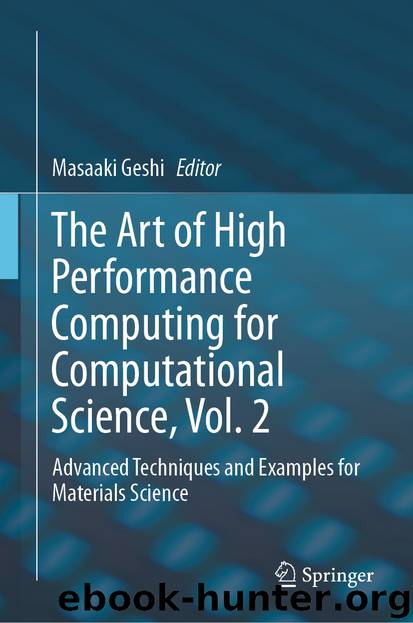The Art of High Performance Computing for Computational Science, Vol. 2 by Masaaki Geshi

Author:Masaaki Geshi
Language: eng
Format: epub
ISBN: 9789811398025
Publisher: Springer Singapore
(4.31)
If we start the Lanczos algorithm with a certain atomic site i as , it is found that . Therefore, can be calculated using the tri-diagonalized matrix . Defining a determinant to be for a matrix which is obtained by excluding the -th rows and the -th columns from a matrix , we have a relation from the Cramer formula. Further, using a recurrence formula derived from the Laplace expansion for a determinant:
(4.32)
we finally obtain the following continued fraction formula:
(4.33)
The continued fraction formula enables us to directly calculate . Once we obtain , the integration of Eq. (4.26) can be performed by a contour integration technique without diagonalizing the matrix H. A method to evaluate the off-diagonal terms of Green functions has been known as bond-order potential methods in which the initial vector is specially chosen [23] or a recurrence formula is employed [24] to calculate the off-diagonal terms.
The computational complexity of the recursion method is mainly governed by the matrix-vector multiplication in Eq. (4.28). The matrix H represented by localized basis functions has a sparse structure, and the number of nonzero elements is O(N). Thus, the computational complexity of the multiplication is O(N). If we take the number of Lanczos steps being proportional to the number of atoms N, we have the computation cost in for each atomic site i, leading to the computational cost in in total. We now consider to reduce the computational complexity by introducing approximations. When the matrix H is truncated around an atomic site i in the multiplication , the computational cost of the Lanczos algorithm for the atomic site i is found to be O(1), leading to no dependency on the number of atoms N. By summing up the contributions of all the atomic sites, the computational complexity becomes O(N) in total. The procedure, that a truncated matrix is introduced for each atomic site and the total Green function is constructed by a patchwork of the fragment of Green function, is a kind of divide-conquer method [25].
Let us illustrate the recursion method with a simple analytic model where the hopping integral is nonzero only for the nearest interaction. The Hamiltonian is given by
Download
This site does not store any files on its server. We only index and link to content provided by other sites. Please contact the content providers to delete copyright contents if any and email us, we'll remove relevant links or contents immediately.
| Coding Theory | Localization |
| Logic | Object-Oriented Design |
| Performance Optimization | Quality Control |
| Reengineering | Robohelp |
| Software Development | Software Reuse |
| Structured Design | Testing |
| Tools | UML |
Deep Learning with Python by François Chollet(12571)
Hello! Python by Anthony Briggs(9916)
OCA Java SE 8 Programmer I Certification Guide by Mala Gupta(9796)
The Mikado Method by Ola Ellnestam Daniel Brolund(9779)
Dependency Injection in .NET by Mark Seemann(9340)
Algorithms of the Intelligent Web by Haralambos Marmanis;Dmitry Babenko(8300)
Test-Driven iOS Development with Swift 4 by Dominik Hauser(7763)
Grails in Action by Glen Smith Peter Ledbrook(7696)
The Well-Grounded Java Developer by Benjamin J. Evans Martijn Verburg(7557)
Becoming a Dynamics 365 Finance and Supply Chain Solution Architect by Brent Dawson(7084)
Microservices with Go by Alexander Shuiskov(6854)
Practical Design Patterns for Java Developers by Miroslav Wengner(6772)
Test Automation Engineering Handbook by Manikandan Sambamurthy(6711)
Secrets of the JavaScript Ninja by John Resig Bear Bibeault(6417)
Angular Projects - Third Edition by Aristeidis Bampakos(6118)
The Art of Crafting User Stories by The Art of Crafting User Stories(5647)
NetSuite for Consultants - Second Edition by Peter Ries(5579)
Demystifying Cryptography with OpenSSL 3.0 by Alexei Khlebnikov(5385)
Kotlin in Action by Dmitry Jemerov(5065)
